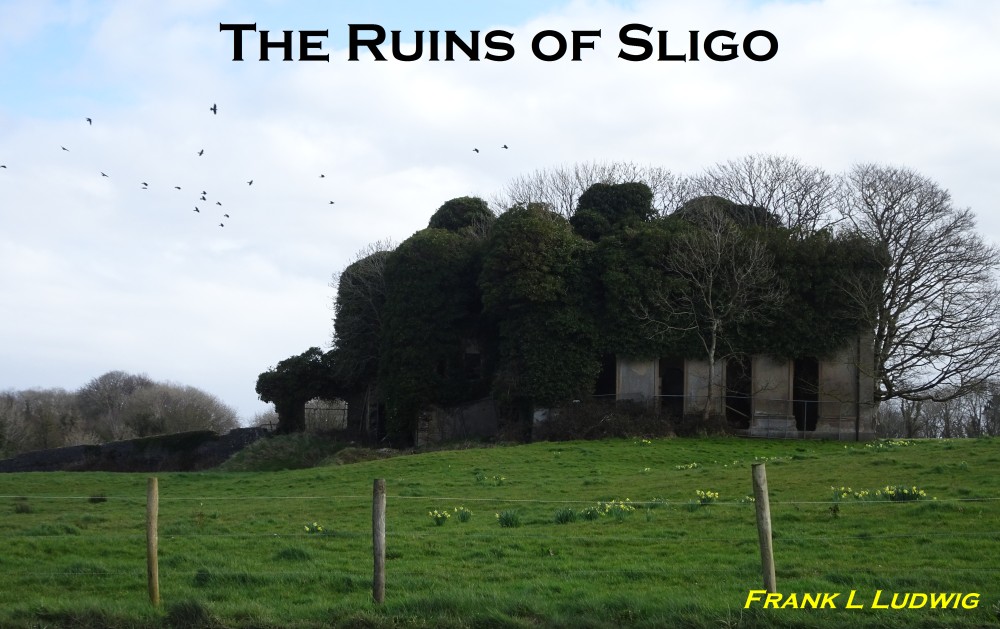
Ruins and Abandoned Buildings in Sligo
For a quarter of a century I've been taking digital photographs of County Sligo, and besides the dramatic landscape, I've always been fascinated by its ruins and abandoned buildings and the stories behind them.
Many of them, like Sligo Abbey, are well-known and well-documented. On this page I cover some of the more obscure ones with a bit of background information.
Clicking on the titles will take you to a gallery with more photographs of the buildings.
|
Ardaghowen House Avena Mills Apartments Drumcliffe Co-Op Creamery Collooney Mills |
Elsinore Lodge Hotel Silver Swan Killaspugbrone Seafield House |
 |
Ardaghowen House Ardaghowen House (formerly Ellenville) was built as a dower house for the Wynne family in 1828. The estate covers 22 acres of scenic parkland along the Garavogue which would provide a great public recreational area; it was auctioned off in 1999 and has been abandoned ever since. The grounds include stables, tennis courts and two jetties at the river. |

|
 |
Avena Mills Apartments Built from 2006 to 2007 as an eyesore to limit the spectacular view of the Owenmore River to those who could afford one of the apartments, the Avena Mills complex in Ballysadare fell victim to the Celtic Tiger's collapse in 2008, and nobody ever lived in it (which is probably for the best since it has been reported that questionable materials were used). The ghost estate is way beyond repair, but there appears to be no intention to demolish it as it gradually slips into the river.
|

|
 |
Collooney Mills
In 1830 Alexander Sim built a mill complex at the Owenmore River in Collooney. The flour was transported to Sligo from where it was shipped overseas.
|

|
 |
Drumcliffe Co-Op Creamery The Drumcliffe Co-Operative Creamery opened in 1895 and was part of a broader movement to shift butter-making from home churns to co-operative processing. One of its main protagonists was Josslyn Gore-Booth who got his sisters Constance and Eva to promote it by wearing armbands with its logo. Business declined throughout the latter part of the 20th century, and it ceased operations in the early 2000s. |

Constance and Eva Gore-Booth showing off their Drumcliffe Co-operative Creamery armbands. |
 |
Elsinore Lodge Elsinore Lodge at the shore of Rosses Point was built by John Black, aka Black Jack, a Sligo merchant and reputed smuggler, probably in the 1820s. In the late 1860s it was purchased by William Middleton, granduncle of the Yeats brothers who spent many of their childhood summers with him. It fell into neglect during the last decades of the 20th century. In 2016 Middleton's descendants repurchased it, but attempts to restore it have been slow due to its status as a protected structure and lack of funding.
|

|
 |
Hotel Silver Swan
The Hotel Silver Swan at Hyde Bridge was opened in 1969 by Minister Brian Lenihan and soon became a popular spot for musical events and first dates. After the owners James and Martha Higgins passed away in 1999, their son Michael took over until the hotel's closure on Christmas Eve 2003. It was demolished about a year later to make way for the Glasshouse Hotel which opened in 2006.
|

|
 |
Killaspugbrone
The church at Killaspugbrone, initially known as Caiseal Irrae, was established in the 5th century while the current stone structure dates to around 1200. And while the church has been depicted as a ruin since the 17th century, the adjacent churchyard has been used well into the 20th century.
|

|
 |
Seafield House
Seafield House was built in 1798 by William Phibbs, an English landlord, and expanded by his grandson William in 1840. The latter's son, Owen Phibbs, went on a graverobbing spree in Egypt in 1855 under the guise of archaeology, as was custom at that time. It had fallen into disrepair by the end of the 19th century and is now considered one of Ireland's most haunted places. (My poem From Thebes to Lisheenacooravan was written about Seafield House.)
|

|







